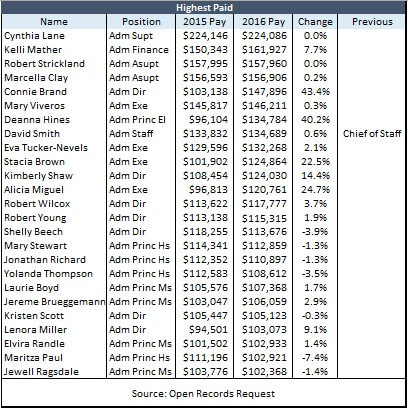Each year, USD# 500 Kansas City, Kansas is one of the last school districts—if not the outright last— to comply with our routine open records requests for yearly payroll data. The district’s tardiness this year meant we were unable to include it in our two-part series on employment and payroll trends in the certain school districts. However, some interesting findings in the data we finally received and posted to KansasOpenGov.org warranted their own post.
The table below shows the district’s 25 highest earners. It is heavily populated with nebulously defined administrative executives and directors, whose position listings this year make their departmental assignments and responsibilities even less obvious than last year. For example, David Smith’s position was listed as “Chief of Staff” but this year is “Adm. Staff,” making it impossible to know if his role has expanded, contracted, or stayed the same. What we do know, however, is that USD# 500 is seemingly the only district we’ve found to provide the Superintendent with a highly-paid Chief of Staff in addition to its sizeable contingent of highly-paid assistant superintendents, directors, and executives.

The district also has 14 additional coordinators listed simply as “Adm. Coor.” with annual pay ranging from $67,000 to $82,000 as well as 43 individuals with a title of “Professional” making anywhere from $7,600 to more than $82,000 annually.
Superintendent Cynthia Lane is the district’s highest paid employee. Among the 25 highest paid, Administrative Director Connie Brand and Elementary Principal Deanna Hines enjoyed the largest pay increases by percentage from last year of 43.4% and 40.2% respectively.
A look at 5-year total pay and staffing trends shows that the findings above are far from single-year anomalies.

Specifically, Superintendent pay rose by almost 12% while total payroll rose by almost 16%.
Staffing changes show that while both classroom teachers and other teachers were added at almost double the rate of enrollment growth, managers and other non-teachers were added at even greater rates of 20.2% and 42.4% respectively.
Many employees in the highest growth category of Other Non-Teachers represent carpenters, custodians, painters, electricians, and secretaries, some of which were identified by Legislative Post Audit as being paid well above market wages for their work. The adjacent table offers just a few examples.

The immediate-term salary costs and long-term pension costs of these decisions forego significant cost savings that could be used in classrooms to directly benefit students. In this vein, a 2013 Legislative Post Audit Study focusing specifically on USD# 500 noted that the district could save between $2.3 and $4.4 million annually by reducing either the number or salaries of custodial and maintenance staff positions.
The study also found that bringing certain administrative and food service salaries in line with market rates would save the district an additional $100,000 to $170,000 annually.
Click here to see the full audit and here to see the USD# 500’s full payroll listing.



